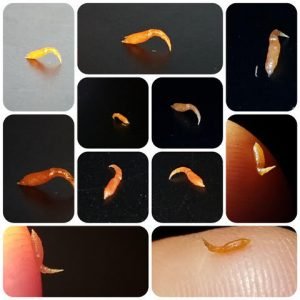
Think of wolf worms like unwelcome guests crashing at a party. They settle in where they don’t belong, often leading to a lot of stress and discomfort for the host—in this case, our furry friends. The technical name for these parasites is *Cuterebra*, and they have a unique life cycle that affects small mammals, particularly squirrels. Understanding more about wolf worms can empower you to take action if you suspect a squirrel in your neighborhood is affected.
What Are Wolf Worms?
Wolf worms, or *Cuterebra*, are the larvae of a type of fly. Female flies lay their eggs near rodent burrows or areas where small mammals are likely to come into contact with them. When the eggs hatch, the larvae latch onto a host, making their way into the body, where they grow and develop. Picture it like a hitchhiker that just won’t get off at its destination.
These larvae often head toward the skin or, in some cases, even find their way into a squirrel’s respiratory system. This is not only uncomfortable for the squirrel but can also lead to serious health issues if left untreated. The symptoms may range from mild to severe, depending on how far along the infestation is.
Identifying Symptoms in Squirrels
So, how do you know if a squirrel is suffering from wolf worms? The signs can vary, and not every squirrel will show the same symptoms. Here are some common indicators to keep an eye out for:
- Behavior Changes: If a squirrel seems less active than usual, or if you notice a lack of interest in foraging, it’s a red flag.
- Visible Lesions: In some cases, you might see swelling or bumps on the skin that can be quite noticeable. This is where the larvae may have entered.
- Respiratory Issues: If a squirrel is coughing or has trouble breathing, it could indicate a more severe infestation.
Honestly, if you see any of these signs, it’s worth keeping a closer eye on the squirrel. Sometimes, these symptoms can mimic other health problems, so no need to panic just yet, but awareness is essential.
How Wolf Worm Infestations Occur
Understanding how these infestations happen can help you take preventive measures. While it’s not easy to completely protect the local squirrel population, knowing the lifecycle of wolf worms can aid in reducing their impact.
1. Egg Laying: The female fly lays eggs in areas where squirrels are likely to wander. These could be near burrows, in soil, or even on the ground where food is scattered.
2. Larvae Attachment: Once the eggs hatch, the larvae eagerly seek a host. They latch onto a squirrel as it brushes by, much like a tick would.
3. Development: Once inside the host, the larvae grow and develop, causing various symptoms as they create holes in the skin or invade other areas.
By understanding this process, you can better appreciate how to keep squirrels safe in your local area. If you see many flies buzzing around, it might be a good idea to limit squirrel access to those spots.
Management and Treatment Options
If you suspect a squirrel is dealing with a wolf worm infestation, there are a few steps you can take. It’s important to handle the situation delicately to ensure the best outcome for the animal.
1. Observation: Start by observing the squirrel from a distance. If you’re able to get a good look, check for any visible symptoms mentioned earlier.
2. Contact a Wildlife Expert: It’s always best to consult a wildlife rehabilitation center or local vet. They can offer guidance and evaluate whether the squirrel can be treated or needs to be rescued.
3. Do Not Attempt Home Remedies: While some people may suggest home remedies or DIY treatments, it’s best to leave these scenarios to the professionals. Attempting to treat the squirrel on your own can lead to unintended harm.
Remember, wildlife professionals are trained to handle these situations safely and humanely. They can provide the appropriate treatment, which may include removing the larvae through a medical process.
Preventing Wolf Worm Infestations
Taking steps to prevent wolf worm infestations is crucial for protecting local squirrels. Here are some simple measures to consider:
- Encourage Natural Predators: Owls and hawks feed on squirrels. By creating a balanced ecosystem, you can help keep squirrel populations in check.
- Avoid Leaving Food Out: If you’re feeding birds or other wildlife, be mindful that leftover food can attract flies.
- Limit Burrows: If you have a garden or outdoor area, consider filling in any unnecessary burrows that might attract female flies to lay their eggs.
By making these changes, you’re not just helping the squirrels; you’re also contributing to a healthier local environment.
The Role of Wildlife Rehabilitation Centers
Wildlife rehabilitation centers play an indispensable role in managing issues like wolf worm infestations. These centers provide much-needed care for injured or sick wildlife, helping them recover and return to their natural habitats.
Many centers offer education on local wildlife, informing the public about signs of health issues in animals like squirrels. They also train volunteers and provide resources for humane practices when it comes to dealing with wildlife.
If you want to support local wildlife, consider volunteering or donating to a local rehabilitation center. They often rely on community support to function and can be an invaluable resource for both animals and the public.
Final Thoughts
Wolf worms in squirrels may sound alarming, but knowledge is your best tool for understanding and addressing this issue. Remember, if you spot any symptoms, it’s essential to take action and reach out to wildlife professionals. They can provide guidance and treatment that keeps these lively creatures healthy and happy.
By being proactive about prevention and spreading awareness, you can help ensure your local squirrel population remains vibrant and free from harm. So keep those eyes peeled, and enjoy watching the squirrels thrive in your yard!
